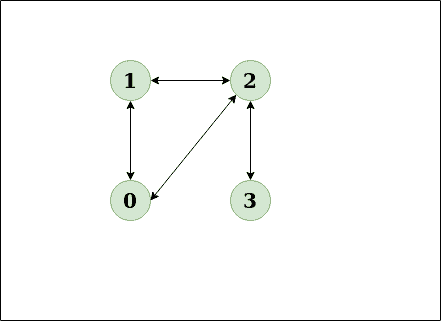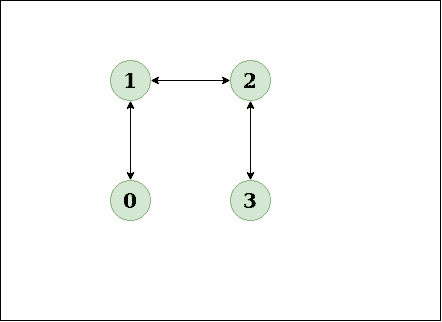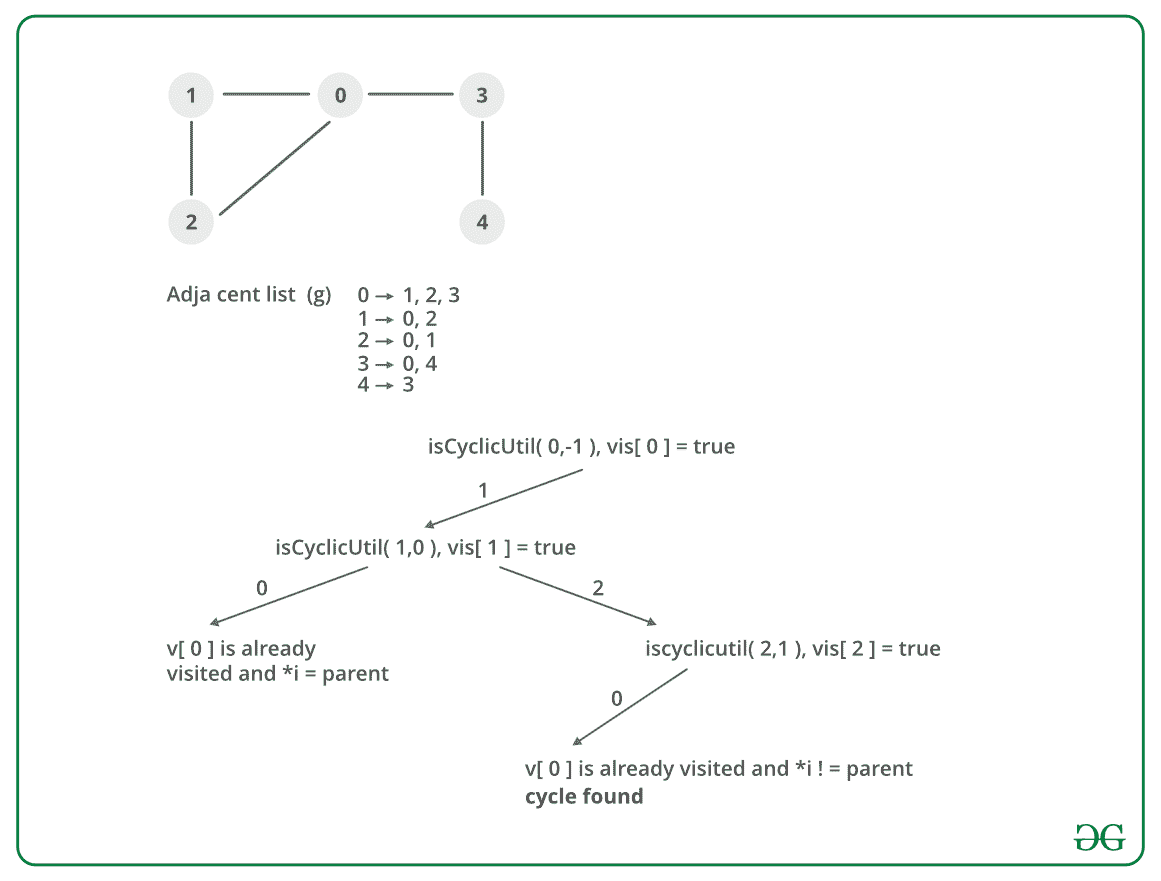给定一个无向图,如何检查图中是否有循环? 实例
null
输入: n=4,e=4 输出: 对 说明: 0 1, 1 2, 2 3, 0 2 图表:

该图清楚地显示了0到2到1到0的循环 输入: n=4,e=3 0 1, 1 2, 2 3 输出: 不 说明: 图表:

这张图表清楚地显示出没有循环
关于周期检测的文章:
方法: 从每个未访问的节点运行DFS。 深度优先遍历 可用于检测图形中的循环。连通图的DFS生成一棵树。只有当图中存在后缘时,图中才有一个循环。后边是将节点连接到DFS生成的树中的自身(自循环)或其祖先之一的边。 要找到其任何祖先的后边缘,请保留一个已访问的数组,如果任何已访问的节点都有后边缘,则存在一个循环并返回true。 算法:
- 使用给定数量的边和顶点创建图形。
- 创建一个包含当前索引或顶点、访问数组和父节点的递归函数。
- 将当前节点标记为已访问。
- 查找所有未访问且与当前节点相邻的顶点。如果递归函数返回true,则递归调用这些顶点的函数。
- 如果相邻节点不是父节点且已被访问,则返回true。
- 创建一个包装器类,该类为所有顶点调用递归函数,如果有函数返回true,则返回true。
- 否则,如果对于所有顶点,函数都返回false返回false。
排练:

实施:
C++
// A C++ Program to detect // cycle in an undirected graph #include<iostream> #include <list> #include <limits.h> using namespace std; // Class for an undirected graph class Graph { // No. of vertices int V; // Pointer to an array // containing adjacency lists list< int > *adj; bool isCyclicUtil( int v, bool visited[], int parent); public : // Constructor Graph( int V); // To add an edge to graph void addEdge( int v, int w); // Returns true if there is a cycle bool isCyclic(); }; Graph::Graph( int V) { this ->V = V; adj = new list< int >[V]; } void Graph::addEdge( int v, int w) { // Add w to v’s list. adj[v].push_back(w); // Add v to w’s list. adj[w].push_back(v); } // A recursive function that // uses visited[] and parent to detect // cycle in subgraph reachable // from vertex v. bool Graph::isCyclicUtil( int v, bool visited[], int parent) { // Mark the current node as visited visited[v] = true ; // Recur for all the vertices // adjacent to this vertex list< int >::iterator i; for (i = adj[v].begin(); i != adj[v].end(); ++i) { // If an adjacent vertex is not visited, //then recur for that adjacent if (!visited[*i]) { if (isCyclicUtil(*i, visited, v)) return true ; } // If an adjacent vertex is visited and // is not parent of current vertex, // then there exists a cycle in the graph. else if (*i != parent) return true ; } return false ; } // Returns true if the graph contains // a cycle, else false. bool Graph::isCyclic() { // Mark all the vertices as not // visited and not part of recursion // stack bool *visited = new bool [V]; for ( int i = 0; i < V; i++) visited[i] = false ; // Call the recursive helper // function to detect cycle in different // DFS trees for ( int u = 0; u < V; u++) { // Don't recur for u if // it is already visited if (!visited[u]) if (isCyclicUtil(u, visited, -1)) return true ; } return false ; } // Driver program to test above functions int main() { Graph g1(5); g1.addEdge(1, 0); g1.addEdge(0, 2); g1.addEdge(2, 1); g1.addEdge(0, 3); g1.addEdge(3, 4); g1.isCyclic()? cout << "Graph contains cycle" : cout << "Graph doesn't contain cycle" ; Graph g2(3); g2.addEdge(0, 1); g2.addEdge(1, 2); g2.isCyclic()? cout << "Graph contains cycle" : cout << "Graph doesn't contain cycle" ; return 0; } |
JAVA
// A Java Program to detect cycle in an undirected graph import java.io.*; import java.util.*; // This class represents a // directed graph using adjacency list // representation class Graph { // No. of vertices private int V; // Adjacency List Representation private LinkedList<Integer> adj[]; // Constructor Graph( int v) { V = v; adj = new LinkedList[v]; for ( int i= 0 ; i<v; ++i) adj[i] = new LinkedList(); } // Function to add an edge // into the graph void addEdge( int v, int w) { adj[v].add(w); adj[w].add(v); } // A recursive function that // uses visited[] and parent to detect // cycle in subgraph reachable // from vertex v. Boolean isCyclicUtil( int v, Boolean visited[], int parent) { // Mark the current node as visited visited[v] = true ; Integer i; // Recur for all the vertices // adjacent to this vertex Iterator<Integer> it = adj[v].iterator(); while (it.hasNext()) { i = it.next(); // If an adjacent is not // visited, then recur for that // adjacent if (!visited[i]) { if (isCyclicUtil(i, visited, v)) return true ; } // If an adjacent is visited // and not parent of current // vertex, then there is a cycle. else if (i != parent) return true ; } return false ; } // Returns true if the graph // contains a cycle, else false. Boolean isCyclic() { // Mark all the vertices as // not visited and not part of // recursion stack Boolean visited[] = new Boolean[V]; for ( int i = 0 ; i < V; i++) visited[i] = false ; // Call the recursive helper // function to detect cycle in // different DFS trees for ( int u = 0 ; u < V; u++) { // Don't recur for u if already visited if (!visited[u]) if (isCyclicUtil(u, visited, - 1 )) return true ; } return false ; } // Driver method to test above methods public static void main(String args[]) { // Create a graph given // in the above diagram Graph g1 = new Graph( 5 ); g1.addEdge( 1 , 0 ); g1.addEdge( 0 , 2 ); g1.addEdge( 2 , 1 ); g1.addEdge( 0 , 3 ); g1.addEdge( 3 , 4 ); if (g1.isCyclic()) System.out.println("Graph contains cycle"); else System.out.println("Graph doesn't contains cycle"); Graph g2 = new Graph( 3 ); g2.addEdge( 0 , 1 ); g2.addEdge( 1 , 2 ); if (g2.isCyclic()) System.out.println("Graph contains cycle"); else System.out.println("Graph doesn't contains cycle"); } } // This code is contributed by Aakash Hasija |
Python3
# Python Program to detect cycle in an undirected graph from collections import defaultdict # This class represents a undirected # graph using adjacency list representation class Graph: def __init__( self ,vertices): # No. of vertices self .V = vertices #No. of vertices # Default dictionary to store graph self .graph = defaultdict( list ) # Function to add an edge to graph def addEdge( self ,v,w): #Add w to v_s list self .graph[v].append(w) #Add v to w_s list self .graph[w].append(v) # A recursive function that uses # visited[] and parent to detect # cycle in subgraph reachable from vertex v. def isCyclicUtil( self ,v,visited,parent): # Mark the current node as visited visited[v] = True # Recur for all the vertices # adjacent to this vertex for i in self .graph[v]: # If the node is not # visited then recurse on it if visited[i] = = False : if ( self .isCyclicUtil(i,visited,v)): return True # If an adjacent vertex is # visited and not parent # of current vertex, # then there is a cycle elif parent! = i: return True return False # Returns true if the graph # contains a cycle, else false. def isCyclic( self ): # Mark all the vertices # as not visited visited = [ False ] * ( self .V) # Call the recursive helper # function to detect cycle in different # DFS trees for i in range ( self .V): # Don't recur for u if it # is already visited if visited[i] = = False : if ( self .isCyclicUtil (i,visited, - 1 )) = = True : return True return False # Create a graph given in the above diagram g = Graph( 5 ) g.addEdge( 1 , 0 ) g.addEdge( 1 , 2 ) g.addEdge( 2 , 0 ) g.addEdge( 0 , 3 ) g.addEdge( 3 , 4 ) if g.isCyclic(): print ( "Graph contains cycle" ) else : print ( "Graph does not contain cycle " ) g1 = Graph( 3 ) g1.addEdge( 0 , 1 ) g1.addEdge( 1 , 2 ) if g1.isCyclic(): print ( "Graph contains cycle" ) else : print ( "Graph does not contain cycle " ) #This code is contributed by Neelam Yadav |
C#
// C# Program to detect cycle in an undirected graph using System; using System.Collections.Generic; // This class represents a directed graph // using adjacency list representation class Graph { private int V; // No. of vertices // Adjacency List Representation private List< int > []adj; // Constructor Graph( int v) { V = v; adj = new List< int >[v]; for ( int i = 0; i < v; ++i) adj[i] = new List< int >(); } // Function to add an edge into the graph void addEdge( int v, int w) { adj[v].Add(w); adj[w].Add(v); } // A recursive function that uses visited[] // and parent to detect cycle in subgraph // reachable from vertex v. Boolean isCyclicUtil( int v, Boolean []visited, int parent) { // Mark the current node as visited visited[v] = true ; // Recur for all the vertices // adjacent to this vertex foreach ( int i in adj[v]) { // If an adjacent is not visited, // then recur for that adjacent if (!visited[i]) { if (isCyclicUtil(i, visited, v)) return true ; } // If an adjacent is visited and // not parent of current vertex, // then there is a cycle. else if (i != parent) return true ; } return false ; } // Returns true if the graph contains // a cycle, else false. Boolean isCyclic() { // Mark all the vertices as not visited // and not part of recursion stack Boolean []visited = new Boolean[V]; for ( int i = 0; i < V; i++) visited[i] = false ; // Call the recursive helper function // to detect cycle in different DFS trees for ( int u = 0; u < V; u++) // Don't recur for u if already visited if (!visited[u]) if (isCyclicUtil(u, visited, -1)) return true ; return false ; } // Driver Code public static void Main(String []args) { // Create a graph given in the above diagram Graph g1 = new Graph(5); g1.addEdge(1, 0); g1.addEdge(0, 2); g1.addEdge(2, 1); g1.addEdge(0, 3); g1.addEdge(3, 4); if (g1.isCyclic()) Console.WriteLine( "Graph contains cycle" ); else Console.WriteLine( "Graph doesn't contains cycle" ); Graph g2 = new Graph(3); g2.addEdge(0, 1); g2.addEdge(1, 2); if (g2.isCyclic()) Console.WriteLine( "Graph contains cycle" ); else Console.WriteLine( "Graph doesn't contains cycle" ); } } // This code is contributed by PrinciRaj1992 |
输出:
Graph contains cycleGraph doesn't contain cycle
复杂性分析:
- 时间复杂性: O(V+E)。 该程序对使用邻接列表表示的图进行简单的DFS遍历。所以时间复杂度是O(V+E)。
- 空间复杂性: O(V)。 要存储访问的阵列,需要O(V)空间。
练习: 我们能用BFS在O(V+E)时间内检测无向图中的循环吗?有向图呢? 如果您发现任何不正确的地方,或者您想分享有关上述主题的更多信息,请写评论
© 版权声明
文章版权归作者所有,未经允许请勿转载。
THE END


![关于”PostgreSQL错误:关系[表]不存在“问题的原因和解决方案-yiteyi-C++库](https://www.yiteyi.com/wp-content/themes/zibll/img/thumbnail.svg)



